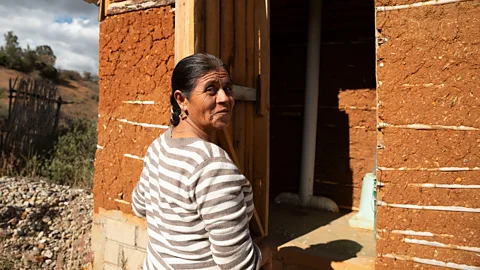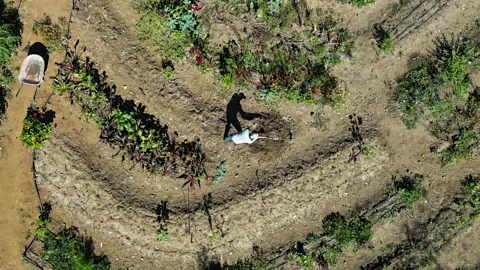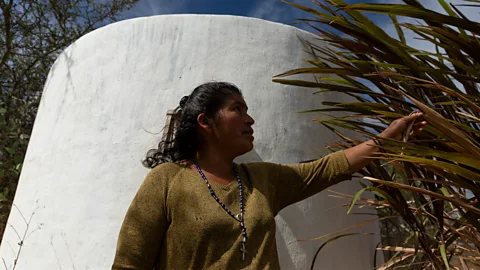In drought-prone Oaxaca, indigenous women are reviving ancient techniques to preserve water
 Stephania Corpi Arnaud
Stephania Corpi ArnaudAs water scarcity threatens their livelihoods, indigenous women in Mexico are relearning how to grow their ancestral foods.
When Agustina Ortiz, 45, returned to her hometown in Oaxaca, Mexico, in 2010 after spending a decade in the US, she was well aware of the type of life that awaited her: a lack of drinking water and a life sustained solely through agriculture.
Like many other Oaxacans, Ortiz and her husband went to the US in search of better opportunities so they could send money back home. "You can't have a life unless someone sends money from abroad," Ortiz says.
The mountains of Oaxaca are harsh and unforgiving. The Zapotec indigenous community of Xixovo, in Santa Maria Velato, is located around 2,000m (6,500ft) above sea level and a two hour drive away from the state's capital. Dry, dusty slopes and yellowed crops decorate the landscape. The scattered fields of agave are a reminder that even in the most challenging conditions, life still finds a way.
When Ortiz returned home in 2010, it was a shock to see that the big trees she had grown up with had died and medicinal plants like chicalote – Mexican prickly poppies – were nowhere to be found.
The first few years back home in Xixovo were a nightmare for Ortiz. She had to hike to the river two or three times a day carrying buckets of water with only the help of her donkey, even while she was pregnant.
 Stephania Corpi Arnaud
Stephania Corpi ArnaudOrtiz felt that each year, heatwaves and drought dominated the season and says that she feels the rain period has become shorter and more unpredictable. Maps from the National Water Commission of Mexico show that a growing number of areas in the region are experiencing severe drought.
Oaxaca suffered one of the most severe droughts in its modern history in 2015 with almost 80% of the state's territory experiencing water-stress. This lack of rain significantly impacted agricultural production, making it difficult for communities like Ortiz's to grow crops, access fresh food, and breed their animals. It's an ongoing issue not just for the region but the entire country. Mexico is currently battling its worst drought in more than a decade, and its residents are experiencing "critical" water shortages.
Becoming self-sufficient
In 2019, along with other mothers from the parent's committee, Ortiz started a vegetable patch at her children's school, the Porfirio Diaz Elementary School, to ensure they were eating nutritious food. The women grow native crops, such as coriander and green beans, as well as onions, garlic and radishes, which require little water. They sell any leftover produce at the market and use the money to make school improvements.
Despite their success, the women knew this project was vulnerable to climate impacts. They were right; when the drought came in 2019, their crops began to fail.
That same year they started working with the non-profit Group to Promote Education and Sustainable Development (Grupedsac), which was founded 30 years ago in Mexico City. The non-profit aims to teach women how to manage water and their land using ancestral ways of irrigation and growing endemic medicinal plants that are drought-resilient.
When Grupedsac began working with Ortiz's community there were two main challenges: increasing droughts were making growing crops difficult and working exclusively with women in a traditionally male-dominated culture.
"We learned very quickly that women were the ones using these technologies but weren't the decision makers of their households. Our mission became to teach them their value in their communities," says Joaquin Carrillo, director of Grupedsac's centre in Oaxaca.
 Stephania Corpi Arnaud
Stephania Corpi ArnaudLearning water resiliency
Grupedsac started by building a 20,000 litre (5,283 gallon) ferro-cement tank, an inexpensive water tank made from cement that needs little maintenance, at the school. The entire community helped build the water tank – an indigenous practice known as tequios, where every person has a civic duty to assist their community.
"We meet them halfway by providing all the materials; but we asked the community to provide the workforce. That's also a way for them to learn and get engaged," says Carrillo.
The water tank collects rain that would usually drain away, which can be reused for cleaning, cooking and, in this case, irrigating the school's crops. Carrillo explains that they aim to prioritise vegetables that are endemic to the region, and are high in iron and protein. Due to high levels of poverty in the region, children's diets are often lacking in nutrition.
 Stephania Corpi Arnaud
Stephania Corpi ArnaudThe tank has a built-in filter that purifies the water to remove bacteria, pathogens and other harmful particles. This prevents gastrointestinal diseases and damage to teeth caused by excessive fluorine which is usually found in higher concentrations in the mountains.
Feeding their families
When Carillo saw the mothers' commitment to growing their own crops, he decided to invite them to Grupedsac's training groups. In 2020, Ortiz and five other women from Xixovo started attending the workshops. To date more than 1,500 women have been part of the programme, with around 280 women from 13 communities currently enrolled.
The women were offered a similar water tank to the one built at the school to have at their homes. But they would have to commit to a four-year programme at Grupsedac's training centre in Ejutla de Crespo, located about an hour from Santa Maria Velato. The workshops equip and train the women how to make the best use of the available water, but also teach them how to build composting waterless toilets and use biofilters to treat water. The women have just finished their training, and Ortiz already has her own 20,000-litre (5,283 gallons) tank installed on her land.
Ortiz relies heavily on the water tank and says it has greatly improved her farming livelihood and the health of her family. "It literally changed my life," she says, while gesturing towards a huge white structure connected to hoses. During the rainy season it helps her collect rainwater through tubes strategically positioned on the metal roof of her house and it also stores water which she pumps from the river.
The tank also stores greywater, from washing the dishes or taking a shower. This water goes through a second natural filtration system which is made of stone, gravel and sand.
Climate Guardians
This article in the Climate Guardians series was ed by funding from the European Journalism Centre, through the Solutions Journalism Accelerator. This fund is ed by the Bill & Melinda Gates Foundation.
Now Ortiz grows her own vegetables including bananas, corn and alfalfa to feed her livestock, which are sustained with the greywater once it has ed through the filtration system.
"I can shower at home now; I used to go to my neighbour's house, and it was very uncomfortable," she says. "I can also water my plants constantly and make some money with what I sell."
Families who own land spanning more than 2.5 acres (1 hectare) can also install infiltration drains that help refill the deep wells which run dry every year due to the lack of rain.
 Stephania Corpi Arnaud
Stephania Corpi ArnaudTzinnia Carranza, general coordinator of Espacio de Encuentro de las Culturas Originarias (Meeting Space for Traditional Cultures), a local non-profit in Oaxaca that works with indigenous communities and recently won the Local Adaptation Champions Awards at COP28, says that water scarcity in the region is also the result of excessive use of agrochemicals that have polluted the few water sources available. "Most rivers are contaminated," says Carranza.
Sanitation systems in Oaxaca are both ineffective and costly to maintain, she says. Local action, such as focusing on treating sewage at the source using technologies like biodigesters (systems that break down organic material such as human waste and food) and bio-filters, or avoiding the use of water with composting toilets, offer "practical solutions with affordable materials", she says.
When it comes to climate change, Oaxaca is the most vulnerable state in Mexico, with the agricultural sectors facing significant threats from drought. The annual rain average in Oaxaca is 1,550mm (61in), according to government data. Carrillo says that the region surrounding Santa Maria Velato receives just 350mm (13.8in) of rainfall per year.
